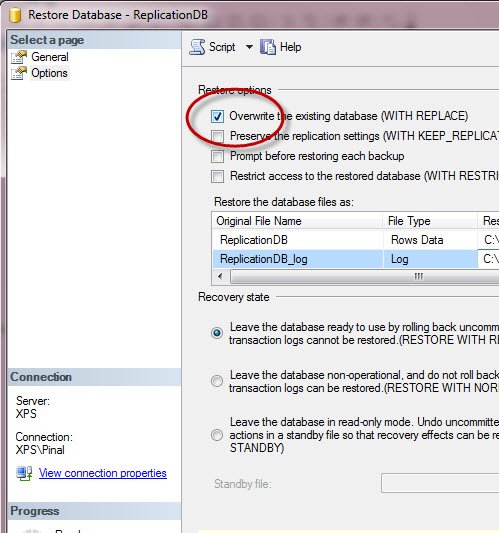I have set up replication at many different organization. One error I quite commonly face is after I have removed replication I can not remove database. When I try to remove the database it gives me following error.
Cannot drop the database because it is being used for replication. (Microsoft SQL Server, Error: 3724)
Fix/Workaround/Solution:
The solution is very simple. Create the empty database with the same name on another server/instance first. Take full back of the same and forced restore over this database.

Do let me know if you have any better idea or suggestion.
Reference : Pinal Dave (https://blog.sqlauthority.com)






41 Comments. Leave new
Believe I had this problem a year ago and the fix was to manually remove the subscriptions. There seemed to be entries left after the SSMS style deletion. Used sp_droppullsubscription on the subscriber and then to follow up cleaning on the publication sp_dropsubscription
I’ll test that out maybe later. This is coming from poor old guy memory ;-)
Hello!
This is a nice, new way to trick the SQL Server into “forgetting” that a database is marked for replication – and is different than the one I am used to using; which has aroused my curiosity.
The databases in the system that I sustain are typically configured in a replicating configuration with one publisher/distributor (our product does not support isolated publisher/distributor configuration) and n number of subscribers (highest count in production is 25). The high-level sequence that we typically follow during a server move and/or server rebuild is:
1. Unregister the subscribers one by one
2. Uninstall the distributor
3. Remove the distribution DB
4. Uninstall publisher
5. Finally run sp_removedbreplication on all servers to remove any meta-data that the server might have remembered
6. Now, backup/remove the databases
My question now is: what is the difference (internally) between sp_removedbreplication and the method described in this article?
Have a great week-end and an exciting week ahead!
Thanks,
Nakul.
Can’t we use this?
EXEC sp_dboption ‘AdventureWorks’,’published’, false
For me, sp_removedbreplication ‘dbname’ usually works.
Excellent!!! This worked for me, thanks.
Gr8….Issue resolved with this.
sp_removedbreplication ‘dbname’ –> worked Thank You.
Thanks…It worked Excellent :)
easy and fast nas. it worked fine
worked perfectly fine for me… short and quickly answer
Hi pinal,
You can try running this sp after removing replication, once the proc is run, try dropping the database.
EXEC sp_replicationdboption @dbname = N’Test_db’, @optname = N’publish’, @value = N’FALSE’ — Remove the replication bit before detaching
GO
Thank you
This is a simple trick but very well-functioning !!!
Thanx a lot…
sp_replicationdboption did the trick.
The SQL Agent has to be started.
Thx
Thanks Ramdas!
(1) Removed the replication using EXEC sp_replicationdboption
(2) Detached the DB
Successful!
EXEC sp_removedbreplication ‘DBName’ did the trick for me as well
Simple solution is to take that database OFFLINE and then delete the database….!
sp_removedbreplication ‘DBName’ ..
Excellent!!! This worked for me, thanks
For remove all objects created by any replication…….
DECLARE @name nvarchar(150), @Tabla Varchar(100), @Instruccion Varchar(250)
DECLARE Objs_cursor CURSOR FOR
SELECT T.Name, O.Name
FROM sys.sysobjects O JOIN sys.tables T On T.object_id=O.parent_obj
WHERE SubString(O.Name,1,7)=’MSmerge’ or SubString(O.Name,1,7)=’repl_id’
order by O.name
OPEN Objs_cursor
FETCH NEXT FROM Objs_cursor
INTO @Tabla, @name
WHILE @@FETCH_STATUS = 0
BEGIN
Set @Instruccion=’ALTER TABLE [‘+@Tabla+’] DROP CONSTRAINT ‘+ rtrim(@Name)
Print @Instruccion
Print ‘GO’
FETCH NEXT FROM Objs_cursor
INTO @Tabla, @name
END
CLOSE Objs_cursor
DEALLOCATE Objs_cursor
DECLARE @name nvarchar(150), @Tabla Varchar(100), @Instruccion Varchar(250)
DECLARE Objs_cursor CURSOR FOR
SELECT T.Name, O.Name
FROM sys.sysindexes O JOIN sys.tables T On T.object_id=O.Id
WHERE SubString(O.Name,1,7)=’MSmerge’
order by T.Name, O.name
OPEN Objs_cursor
FETCH NEXT FROM Objs_cursor
INTO @Tabla, @name
WHILE @@FETCH_STATUS = 0
BEGIN
Set @Instruccion=’DROP INDEX [‘+ rtrim(@Name)+’] ON [dbo].[‘+rtrim(@Tabla)+’] WITH ( ONLINE = OFF )’
Print @Instruccion
Print ‘GO’
FETCH NEXT FROM Objs_cursor
INTO @Tabla, @name
END
CLOSE Objs_cursor
DEALLOCATE Objs_cursor
DECLARE @name nvarchar(150), @Tabla Varchar(100), @Instruccion Varchar(250)
DECLARE Objs_cursor CURSOR FOR
SELECT Name B, Name A
FROM sys.sysobjects
WHERE SubString(Name,1,7)=’MSmerge’
order by name
OPEN Objs_cursor
FETCH NEXT FROM Objs_cursor
INTO @Tabla, @name
WHILE @@FETCH_STATUS = 0
BEGIN
Set @Instruccion=’Drop View [‘+ rtrim(@Name)+’]’
Print @Instruccion
Print ‘GO’
FETCH NEXT FROM Objs_cursor
INTO @Tabla, @name
END
CLOSE Objs_cursor
DEALLOCATE Objs_cursor
DECLARE @name nvarchar(150), @Tabla Varchar(100), @Instruccion Varchar(250)
DECLARE Objs_cursor CURSOR FOR
SELECT Name
FROM sys.tables
order by name
OPEN Objs_cursor
FETCH NEXT FROM Objs_cursor
INTO @name
WHILE @@FETCH_STATUS = 0
BEGIN
Set @Instruccion=’ALTER TABLE[‘+ rtrim(@Name)+’] DROP COLUMN rowguid’
Print @Instruccion
Print ‘GO’
FETCH NEXT FROM Objs_cursor
INTO @name
END
CLOSE Objs_cursor
DEALLOCATE Objs_cursor
And for remove replication tables:
SET NOCOUNT ON
DECLARE @tablename NVARCHAR(128)
DECLARE @RC INT
DECLARE curTable CURSOR FOR
SELECT [name] AS tbl
FROM sys.objects
OPEN curTable
FETCH NEXT FROM curTable
INTO @tablename
WHILE @@FETCH_STATUS = 0
BEGIN
EXECUTE @RC = dbo.sp_MSunmarkreplinfo @tablename
FETCH NEXT FROM curTable
INTO @tablename
END
CLOSE curTable
DEALLOCATE curTable
GO
Finaly for permanently remove replication:
exec sp_removedbreplication ‘DB’
Send your comments…. [email removed]
Nice script works for me help me lot
Take the database offline and then delete it using SSMS.
Thank you! That worked.
EXEC sp_dboption ‘AdventureWorks’,’published’, false
works perfect for me
Took database offline and then it dropped just fine.
Thanks Mukul
Great, thank you!
Super and thank you.
Restore database is worked for me
thank you very much ^_^ it’s work!!!!
Very good…:-)
Stoffel – glad that you liked it.